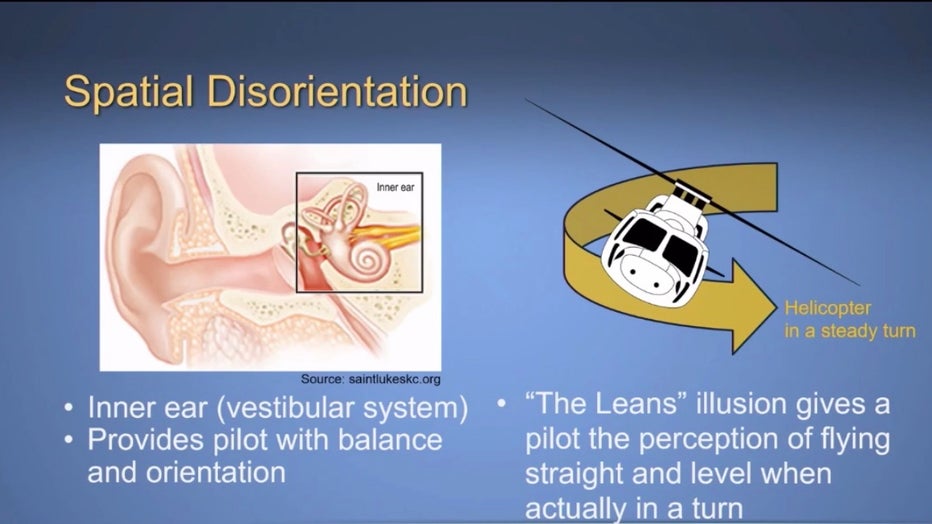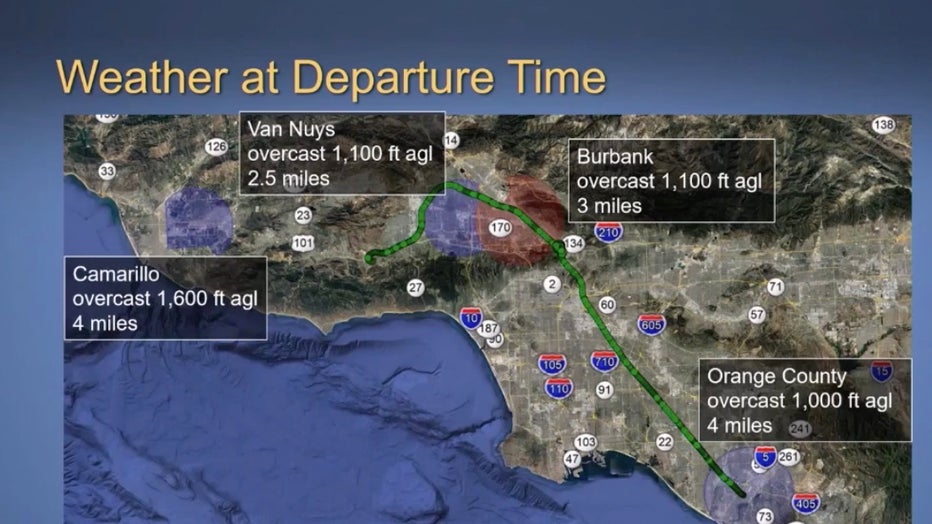Kobe Bryant helicopter pilot had spatial disorientation in deadly crash: NTSB
WASHINGTON - The National Transportation Safety Board revealed the likely cause of the deadly helicopter crash that took the lives of nine Southern California residents, including NBA legend Kobe Bryant and his 13-year-old daughter on Tuesday.
During Tuesday’s board meeting, the NTSB was critical of veteran pilot Ara Zobayan's actions in the final moments of the flight from when the aircraft entered the Van Nuys airspace to when it collided with the hilly terrain in Calabasas.
"There were opportunities along the way to have reversed the course and prevented this crash by simply landing," NTSB Chairman Robert Sumwalt said.
In the 13 findings in the investigation, the NTSB highlighted its seventh, which states the crash was likely caused by the pilot’s decision to continue the flight due to self-induced pressure to fulfill his client’s travel needs, lack of an alternative plan and plan-continue bias.
The latest update of the investigation comes exactly two weeks after the one-year mark of the tragic crash.
In interviews conducted throughout the investigation, federal officials discovered that Bryant and Zobayan developed a friendship that may have led to his self-induced pressure to please his high-profile client.
To emphasize their findings, authorities mentioned the deadly aircraft crashes involving Stevie Ray Vaughan and Aaliyah to point out how a pilot can face self-induced pressure when dealing with celebrity clientele.
When it comes to the plan-continuation bias, NTSB said Zobayan continued the flight despite changing weather conditions, leading to poor in-flight decision making and violating multiple flight standards, going against his years of training.

(NTSB)
An NTSB official described the spatial disorientation Zobayan likely experienced in the clouds the moments before taking a left into a Calabasas hillside in the Santa Monica mountains. Notably, Zobayan was not authorized to fly in heavy clouds.
The NTSB said Zobayan experienced an illusion called "The Leans," which gives a pilot the perception of flying straight and level when actually in a turn.
From 2010-2019, there have been 184 deadly aircraft accidents as a result of pilots experiencing spatial disorientation.

A preliminary NTSB report from last February revealed wreckage from the helicopter did not show any evidence of engine failure.
Investigators focused heavily on the moments of the flight that occured after Zobayan entered the Van Nuys airspace and said his actions "were not consistent with his training." Zobayan was an experienced pilot who logged 8,577 hours of flying. He was also up-to-date on his certifications and was qualified to fly under Visual Flight Rules (VFR).

"As long as we continue to have VFR-only helicopters continuing to flirt with marginal weather and sometimes submarginal weather, low altitudes, low ceilings, limited visibility…unfortunately certain percentage of them will stray into inverted IMC [instrument meteorological conditions] and unfortunately, a certain percentage of them will not come out alive," said Michael Graham with the NTSB.
Being well-trained and a flight instructor himself, federal investigators added that "the path and behavior were not consistent with committing to the instruments," inside the aircraft.
That morning, as he continued to proceed westbound toward Calabasas, he encountered thick fog and took a left turn as the helicopter began to descend rapidly in the hilly terrain at a high speed, federal investigators said.

RELATED: One Year Later: Honoring the 9 victims of the Calabasas helicopter crash
Bryant and his 13-year-old daughter Gianna were among the eight passengers who boarded the luxury 1991 Sikorsky S-76B helicopter, operated by Island Express Helicopters, the morning of Jan. 26, 2020, from Orange County’s John Wayne Airport. Reports revealed the pilot and the passengers all took the same flight to the Camarillo Airport the day before without incident.

Exemplar photo of N72EX (NTSB)
However, that particular morning presented a shift in weather conditions. Due to thick fog, many flights were grounded in the area, including the choppers of local police agencies.

The weather conditions at the time of the crash (NTSB)
Bryant was known to take helicopters to outsmart Southern California’s grueling traffic. The drive from Newport Coast where the Bryant family resides to Thousand Oaks would take an estimated two hours. In a helicopter, the commute would be cut down to about half an hour.
The retired NBA superstar coached Team Mamba, Gigi’s AAU basketball team with Christina Mauser who was also aboard the doomed helicopter.
Also onboard were Alyssa Altobelli, 14, and her parents John and Keri, 13-year-old Payton Chester and her mom, Sarah, and pilot Ara Zobayan.
Zobayan was considered one of the most sought-after pilots in Southern California and had several high-profile clients including Kawhi Leonard and Kylie Jenner.
According to the NTSB, the pilot did get a weather report before departing the Orange County airport.
At the flight's departure time, Van Nuys was the only airport to report visibility under 3 miles.

(NTSB)
RELATED: ‘He was one of the few people I would trust with my life’: Pilot in Kobe Bryant crash remembered
The teen girls were scheduled to participate in a basketball tournament at what was then called the Mamba Sports Academy, co-owned by Kobe Bryant, in Thousand Oaks.
In an interview with the Daily Mail, Bryant’s assistant Cate Brady revealed that the night before the crash, he requested to move up the flight time by 45 minutes to 9 a.m. so he could watch another team play before Team Mamba was set to take the court.
Team Mamba was set to go against Drive Nation, coached by fellow retired NBA star, Jason Terry.
The NTSB detailed the following timeline of the deadly crash:
9:07 a.m.: Zobayan and the eight passengers departed the John Wayne Airport in Santa Ana in a "northwest direction" at an altitude of about 700 to 800 feet mean sea level (msl) under visual flight rules (VFR)."
The investigation revealed the pilot did get a weather report before departure and the NTSB does not believe the flight should have been delayed.
9:20 a.m.: While approaching the Burbank Airport airspace, air traffic controllers instructed Zobayan to hold and asked him to state his intention for the duration of the flight. Zobayan told them he planned to head west and would follow the 101 Freeway, also requesting VFR rules.
NTSB's report said: "In response to the pilot’s request, the air traffic controller advised that cloud tops were reported at 2,400 feet msl and queried the pilot’s intentions; the pilot then requested a special VFR clearance (an ATC authorization to proceed in controlled airspace at less than VFR weather minima). The air traffic controller advised that the pilot would need to hold for a short time due to IFR traffic, which the pilot acknowledged. At 0932, ATC cleared the pilot of N72EX to transition the class C surface area following the I-5 freeway, maintaining special VFR conditions at or below 2,500 feet. The pilot acknowledged with a correct readback and climbed to approximately 1,400 feet msl. In response to the query, the pilot replied to the Burbank ATC that he would follow Highway 118 and "loop around VNY [Van Nuys Airport]' to follow Highway 101."
9:32 a.m.: Zobayan is given clearance to proceed by air traffic controllers. Zobayan planned to travel south of the San Fernando Valley by following the 101 Freeway. He is told to follow Interstate 5 then State Route 118. At this point, Zobayan also requested radar assistance from air traffic control, also known as "flight following."
9:39 a.m.: As the aircraft passed west of Van Nuys at 1,500 msl, a Van Nuys controller said he would not be able to continue radar contact and advised Zobayan to contact the Southern California Terminal Radar Approach Control (SCT). At this point, the aircraft was surrounded by thick fog.

(NTSB)
9:45 a.m.: SCT then took over when Zobayan informed them he was going to Camarillo at an altitude of 1,500 feet. That air traffic controller was "immediately relieved by a different controller."
Zobayan attempted to reach SCT to inform them he was "climbing above cloud layers and requested advisory services."

(NTSB)
The air traffic controller who took over was unaware of the aircraft "as services had previously been terminated," and asked Zobayan to identify flight information. Zobayan then said he climbing to an altitude of 4,000 feet when the two lost contact.
He was asked to identify ("ident") his flight. At this point, investigators believe pushing the "ident" bottom introduced distractions, also stating that: "Interruptions in the pilot's instrument scan, head and hand movements would make the pilot more vulnerable to misleading vestibular cues."

Camera image from 0944 PST (NTSB)
9:47 a.m.: The helicopter crashed into a Calabasas hillside near the intersection of Las Virgenes Road and Willow Glen Street. The fiery crash followed multiple 911 calls. Arriving law enforcement officials confirmed there were no survivors.
Last year, federal authorities said one of the key factors in the investigation focused on the fact that the Sikorsky S-76B helicopter was not equipped with a terrain alarm system, cockpit voice recorders or flight data recorders, federal officials said.
RELATED: FAA faces criticism from federal investigators over helicopter recommendations
According to NTSB: "The helicopter was not equipped with a flight data recorder or cockpit voice recorder (CVR) nor was it required to be for the accident flight. The helicopter was equipped with a four-axis automatic flight control system, electronic flight instrument system, radio altimeter, and ADS-B transponder. It was also equipped with a flight management system (FMS). The airworthiness group retained the FMS computer to examine it for any available recorded data stored in memory, and also retained two flight control computers, four gyros, and the standby attitude indicator for further examination. A number of personal electronic devices were recovered from the wreckage and will be examined for any relevant data."

On Tuesday, the NTSB reiterated the fact that the helicopter was not equipped with a safety management system (SMS) and that Island Express "was aware of but not involved with SMS."
Over a year after the deadly crash, SMS is still not required by the FAA for helicopters.
RELATED: News related to the life and death of NBA legend Kobe Bryant
Days after the tragedy, U.S. Congressman Brad Sherman (D-Sherman Oaks) introduced the Kobe Bryant and Gianna Bryant Helicopter Safety Act, which would require the FAA to strengthen federal safety standards for helicopters.
The NTSB also said Tuesday another preventable measure could have been having two pilots, which would have allowed the second pilot to take over as the main pilot became disoriented.
On the morning of Kobe and Gianna’s Celebration of Life held at Staples Center, also known as the "House that Kobe Built," on Feb. 24, 2020 (the numbers 2 and 24 representing Kobe and Gigi's jersey numbers), Vanessa Bryant filed a wrongful death lawsuit against Island Express Helicopters, Inc.
Her lawyers said they believe Kobe and Gianna suffered emotional trauma as Zobayan attempted to navigate out of the clouds.
In August, it was revealed Island Express Helicopters is also being sued by air traffic controllers.
Vanessa Bryant also filed a second lawsuit in September 2020 against OC Helicopters, LLC.
RELATED:
Kobe Bryant's widow sues helicopter operator for deaths
Vanessa Bryant sues second helicopter company in fatal Kobe Bryant crash
The Altobelli and Mauser families have also filed wrongful death/negligence lawsuits.
RELATED: More lawsuits filed in connection with chopper crash that killed Kobe Bryant
To continue their legacies and love for sports, Vanessa Bryant renamed the Mamba Sports Foundation the Mamba and Mambacita Sports Foundation to honor her late daughter.
RELATED: 'He was like Hercules to me': Girl, 12, wants to continue Kobe and Gianna Bryant's legacy

(Christina Mauser (www.christinamauserfoundation.org))
Matt Mauser started the Christina Mauser Foundation in honor of his late wife to support girls who are interested in sports, especially girls from underserved communities.
This story was reported from Los Angeles.
Get your top stories delivered daily! Sign up for FOX 11’s Fast 5 newsletter. And, get breaking news alerts in the FOX 11 News app. Download for iOS or Android.

